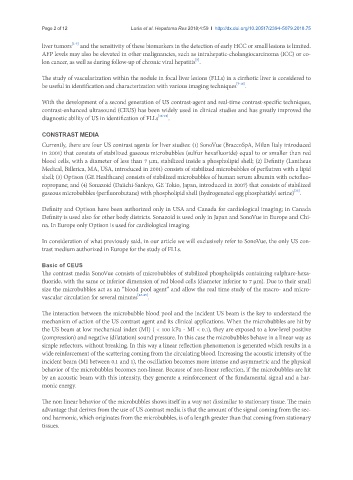Page 641 - Read Online
P. 641
Page 2 of 12 Loria et al. Hepatoma Res 2018;4:59 I http://dx.doi.org/10.20517/2394-5079.2018.75
[2-5]
liver tumors and the sensitivity of these biomarkers in the detection of early HCC or small lesions is limited.
AFP levels may also be elevated in other malignancies, such as intrahepatic-cholangiocarcinoma (ICC) or co-
[6]
lon cancer, as well as during follow-up of chronic viral hepatitis .
The study of vascularization within the nodule in focal liver lesions (FLLs) in a cirrhotic liver is considered to
be useful in identification and characterization with various imaging techniques [7-16] .
With the development of a second generation of US contrast-agent and real-time contrast-specific techniques,
contrast-enhanced ultrasound (CEUS) has been widely used in clinical studies and has greatly improved the
diagnostic ability of US in identification of FLLs [16-21] .
CONSTRAST MEDIA
Currently, there are four US contrast agents for liver studies: (1) SonoVue (BraccoSpA, Milan Italy introduced
in 2001) that consists of stabilized gaseous microbubbles (sulfur hexafluoride) equal to or smaller than red
blood cells, with a diameter of less than 7 µm, stabilized inside a phospholipid shell; (2) Definity (Lantheus
Medical, Billerica, MA, USA, introduced in 2001) consists of stabilized microbubbles of perflutren with a lipid
shell; (3) Optison (GE Healthcare) consists of stabilized microbubbles of human serum albumin with octofluo-
ropropane; and (4) Sonazoid (Daiichi-Sankyo, GE Tokio, Japan, introduced in 2007) that consists of stabilized
[22]
gaseous microbubbles (perfluorobutane) with phospholipid shell (hydrogenated egg phosphatidyl serine) .
Definity and Optison have been authorized only in USA and Canada for cardiological imaging; in Canada
Definity is used also for other body districts. Sonazoid is used only in Japan and SonoVue in Europe and Chi-
na. In Europe only Optison is used for cardiological imaging.
In consideration of what previously said, in our article we will exclusively refer to SonoVue, the only US con-
trast medium authorized in Europe for the study of FLLs.
Basic of CEUS
The contrast media SonoVue consists of microbubbles of stabilized phospholipids containing sulphure-hexa-
fluoride, with the same or inferior dimension of red blood cells (diameter inferior to 7 µm). Due to their small
size the microbubbles act as an “blood pool agent” and allow the real time study of the macro- and micro-
vascular circulation for several minutes [23-25] .
The interaction between the microbubble blood pool and the incident US beam is the key to understand the
mechanism of action of the US contrast agent and its clinical applications. When the microbubbles are hit by
the US beam at low mechanical index (MI) ( < 100 kPa - MI < 0.1), they are exposed to a low-level positive
(compression) and negative (dilatation) sound pressure. In this case the microbubbles behave in a linear way as
simple reflectors, without breaking. In this way a linear reflection phenomenon is generated which results in a
wide reinforcement of the scattering coming from the circulating blood. Increasing the acoustic intensity of the
incident beam (MI between 0.1 and 1), the oscillation becomes more intense and asymmetric and the physical
behavior of the microbubbles becomes non-linear. Because of non-linear reflection, if the microbubbles are hit
by an acoustic beam with this intensity, they generate a reinforcement of the fundamental signal and a har-
monic energy.
The non linear behavior of the microbubbles shows itself in a way not dissimilar to stationary tissue. The main
advantage that derives from the use of US contrast media is that the amount of the signal coming from the sec-
ond harmonic, which originates from the microbubbles, is of a length greater than that coming from stationary
tissues.

